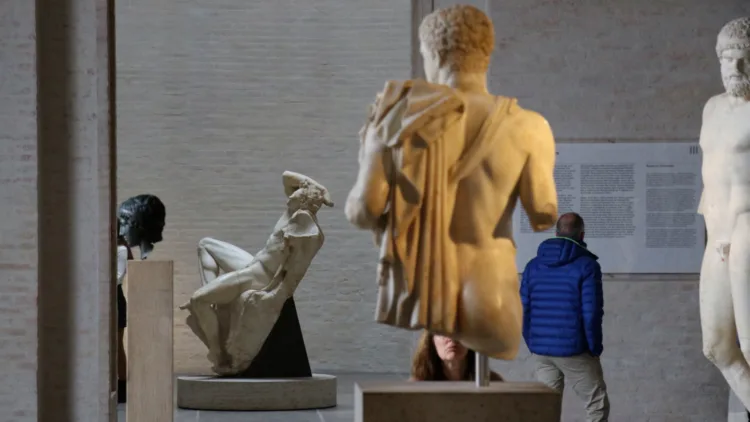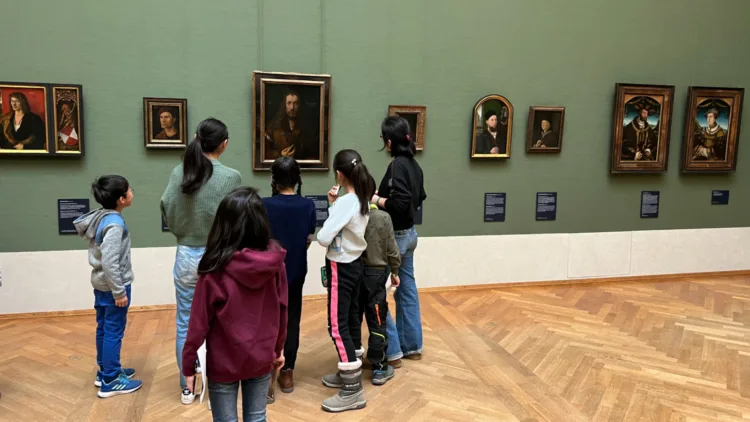Munich has many superb art museums and galleries with fantastic artworks and collections ranging from antiquity to contemporary, but where do you have to go to see the best?

Some of the best art collections in Germany are in museums in Munich where admission is relatively cheap and easy. Almost all the top museums are located in the Kunstareal area near München Hauptbahnhof and downtown. The antiquities collection, including the Greek and Roman sculptures in the Glyptothek, is one of the best in the world. The Old Master paintings in the Alte Pinakothek give a comprehensive overview of European art from the late Middle Ages to the Baroque while the Neue Pinakothek is filled with 19th-century art including works by the German Romantics and French Impressionists. Several museums in Munich cover 20th-century, modern, and contemporary art.
Art Museums and Galleries in the Kunstareal Munich
Most of Munich’s top art museums and galleries are located in the so-called Kunstareal (art area) just north of München Hauptbahnhof (main central train station). This area, measuring only around half a square kilometer, has almost 20 public museums or exhibition spaces, more than 40 private commercial art galleries, six art academies, and numerous further cultural and academic institutions. Almost all of the venues in this article are located in this area.
Getting to the museums and galleries in the Kunstareal is easy on public transportation, while many may find walking from the train station and the center of Munich also a good option. The closest metro stations (U-Bahn) are Königstplatz, THeresienstraße, Universität, or Odeonsplatz while bus 100 and tram 27/28 pass right through the Kunstareal with several convenient stops including Pinakotheken and Karolingenplatz.
Museum hours are mostly at least 10:00 to 17:00 with many open until 20:00 at least one evening per week. Museums are mostly closed on Mondays.
Museum ticket prices in Munich remain relatively low and are generally cheaper than in Berlin or other major European cities. Ticket prices range from around €6 to €10 with many museums charging only €1 on Sundays. Admissions are usually covered or discounted by the Munich Card or City Pass.
Museums with Art from Antiquity in Munich
Where to see antiquities in Munich? The four top antiquities museums, and the Glyptothek is one of the best in the world, are all located within a block of each other:

Greek and Roman Sculptures: The absolute highlights of Munich’s antiquities are displayed in the neo-classical Glyptothek on Königsplatz. This is the world’s only museum dedicated solely to Greek and Roman sculptures from antiquity. It is also one of the best collections in the world — in the early 19th century, the Bavarian royal family bought quality, which forms the core of this exquisite collection. Highlights in the Glyptothek include the Barberini Faun (or Sleeping Satyr), the Kouros of Tenea, an Aphrodite of Cnidus, the Dying Ilioneus, the Apollo Barberini, and the Artemis Braschi.
Antiquities: Across the square in another neo-classical temple is the rest of the State Antiquities Collection (Staatliche Antikensammlungen). These include masterpieces from Greek vases, Etruscan gold jewelry, glass, implements, and smaller bronze or clay figurines.
Egyptian Art: The oldest art and artifacts on display in Munich are in one of the newest and decisively modern museum buildings. The State Museum of Egyptian Art (Staatliches Museum Ägyptischer Kunst / SMÄK) is Germany’s only subterranean museum (but it is brightly lit via an atrium) and opened in 2013. The collection spans 5000 years with the statuary especially highly praised.
Plaster Copies: Although many works were lost in the Second World War, the Museum of Plaster Copies of Classical Sculptures (Museum für Abgüsse Klassischer Bildwerke) is still worth a quick visit — admission is free.
European Art Museums in Munich

A visit to the Alte and Neue Pinakotheken in Munich gives visitors a comprehensive overview of European paintings from the late Middle Ages to the early 20th century. Smaller museums expand specific themes while many galleries are filled with modern and contemporary art.
Old Masters: The Alte Pinakothek was the world’s largest museum when it opened in 1826 and with over 700 paintings on permanent display, it is still one of the largest and most important collections of Old Master paintings in the world. The collections of early German and Netherlandish paintings are exceptionally comprehensive while the Italian masterpieces include the only Leonardo da Vinci painting in Germany, three madonnas by Raphael, and early works by Giotto and Fra Angelico. The Peter Paul Rubens collection of 72 works is unrivaled. The best-known painting here is Self-Portrait with Fur-Trimmed Robe by Albrecht Dürer — an absolute highlight of German and Renaissance art.
19th-Century Art: The Neue Pinakothek is usually the home of the ever-popular 19th-century art but the museum is closed for renovation until at least 2029. The highlights from this collection are on display in the Alte Pinakothek, Sammlung Schack, and other temporary venues. Impressionists are well represented including works by Renoir, Manet, Monet, Cezanne, Gaugin Degas, Max Liebermann, Max Slevogt, and several by Van Gogh. German romanticism remains popular with noted works by Caspar David Friedrich, Karl Friedrich Schinkel, and Carl Blechen. All other European art movements are covered from the late 18th century to early 20th-century art nouveau (Jugendstil). The 3000-strong collection also includes around 50 sculptures.
Sammlung Schack: Mostly 19th-century Romanticism paintings bought as contemporary art and exhibited in a purposely built gallery. It includes works by Carl Spitzweg, Franz con Lenbach, Anselm Feuerbach, and Arnold Böcklin, as well as good copies of famous paintings produced to bring this art to the attention of people who could not travel to see the originals. (Some works from the Neue Pinakothek are on temporary display here but the more popular ones are in the Alte Pinakothek.)
Baroque Art: The best baroque paintings are in the Alte Pinakothek but the various royal palaces of Munich are also filled with art, especially Baroque, Rococo, and neo-classical paintings, sculptures, and decorations. The Munich Residenz is famous for its Hall of Antiquities (the largest Renaissance hall north of the Alps) and treasury of the Wittelsbachs (Bavarian royal family). The royal summer palace, Schloss Nymphenburg, has expansive gardens but also a rich interior and the Gallery of Beauties of King Ludwig I. Schloss Schleissheim has a rare original Baroque garden and many Baroque paintings but the best ones are in the Alte Pinakothek.
Modern and Contemporary Art Museums in Munich
Munich has several museums with 20th-century, modern, and contemporary art on display:
The Pinakothek der Moderne is the giant of modern art museums in Munich. This huge building includes four museums. The over 20,000 works of the Sammlung Moderne Kunst cover all major international art genres from the early 20th century to the present. It has an outstanding collection of classical modernism including key works by Max Beckmann, August Macke, Ernst Ludgwig Kirchner, and Paul Klee. It also has significant works from the 1960s including by Joseph Buys and Andy Warhol. The other three museums here are on architecture, graphics, and design.
The Blue Rider: The Lennbachhaus has the largest collection of Der Blaue Reiter art in the world and although the museum covers much more, the colorful pre-First World War paintings are still the main reason to visit. (Similar works are mostly in the huge Pinakothek der Moderne.)
Museum Brandhorst: the name gives nothing away but this museum has one of the most important collections of pop art in Europe, including around 100 works by Andy Warhol and 60 by Cy Twombly. All major international artists from the 1960s to the present are covered. (The museum apparently has the largest annual acquisition budget of any collection in Munich.)
MUCA: The Museum of Urban and Contemporary Art is a small private venue with frequently changing temporary exhibitions in the center of Munich. Artists such as Damien Hirst and Banksy seem particularly popular.
Kunstpavillon— a small but usually free art venue used for contemporary art. It is at the edge of the Kunstareal just off the Stachus major transportation hub in central Munich.
More on Top Art Museums in München
- Where to See What — a brief description of Munich’s top art museums and galleries.
- Alte Pinakothek — top Old Master paintings (and some 19th-century paintings while the Neue Pinakothek is under renovation.)
- Glyptohek — one of the world’s best Greek and Roman sculpture collections from antiquity.
- Lenbachhaus — the largest The Blue Rider collection in the world but also modern art exhibitions.
- Save with the Munich Card and City Pass on transportation and sightseeing — most museums are covered.
- Visit the royal castles of King Ludwig II near Munich to see the 19th-century historicist interiors of Schloss Neuschwanstein, Linderhof, and Herrenchiemsee Palace.







